Hi everyone! I am happy to share that I have completed my second game jam project! In this post I will be going over the game, as well as my sound design and music composition process. My last post regarding this topic was very well received, so I am really excited to dive deep into my process once more!
Game design
For this jam, I was working with artist Val and programmer Ray. Compared to the last jam, this was the smallest team I have worked with. We got together and once we got the jam’s theme, depths, we got to work with ideation. We had a lot of crazy ideas in the beginning, including a microscope game where you zoom in on bacteria. We also talked about how we could peer deep into someone’s eyes with a sort of telescope device.
After all of the wacky ideas we’ve thrown against the wall, what stuck was a game where you play as a demon, who is watering a hell plant in the middle of Death Valley, causing chaos and destruction for the earth. The idea behind the challenge and gameplay was to create a game similar to games like Overcooked, where the player is tasked to achieve a goal while managing different tasks. In the case of our game, the tasks were the demands of different liquids the plant was requesting to drink. We don’t make the rules here, the plant wants what the plant wants, and it’s up to you to satisfy its thirst!
Ray got started with the programming, Val with her 3D art, and myself with the music and sound effects. This time, with the team size we had, I was doing all of the sounds solo. Not only was this aspect different from my last jam, but we all did our work remotely. For the work itself, it ended up not being too bad remote. After all, I pretty much spent most of the last jam doing the majority of the work remotely anyway. What was different this time around was that I was reliant on my team making frequent communication with our team chat. Fortunately, our team had great communication, but it was a different sort of animal compared to seeing the project grow in real time when you’re in person.
In the end, I was able to contribute my share. I ended up making a lot of great sound decisions for the mood and feel of the final game, even if I felt like I was flying blind through some of it. Before I describe how I went about the sound, I just want to take note here that being able to put all the pieces together like this is a true testament to the talent our entire team has. I am truly grateful to be able to be a part of it!
Sound Effects
This time, I will go over everything under a general “sound effects” heading. This is because, compared to the previous game I worked on, this game was fairly grounded in reality, sound-wise. Most of the sound effects just involved me recording the real-life equivalent and then cleaning up the audio. I will say that it was pretty funny to pour some sparkling water on some dirt for the sound of watering the plant with soda. I can only imagine what my neighbors thought!
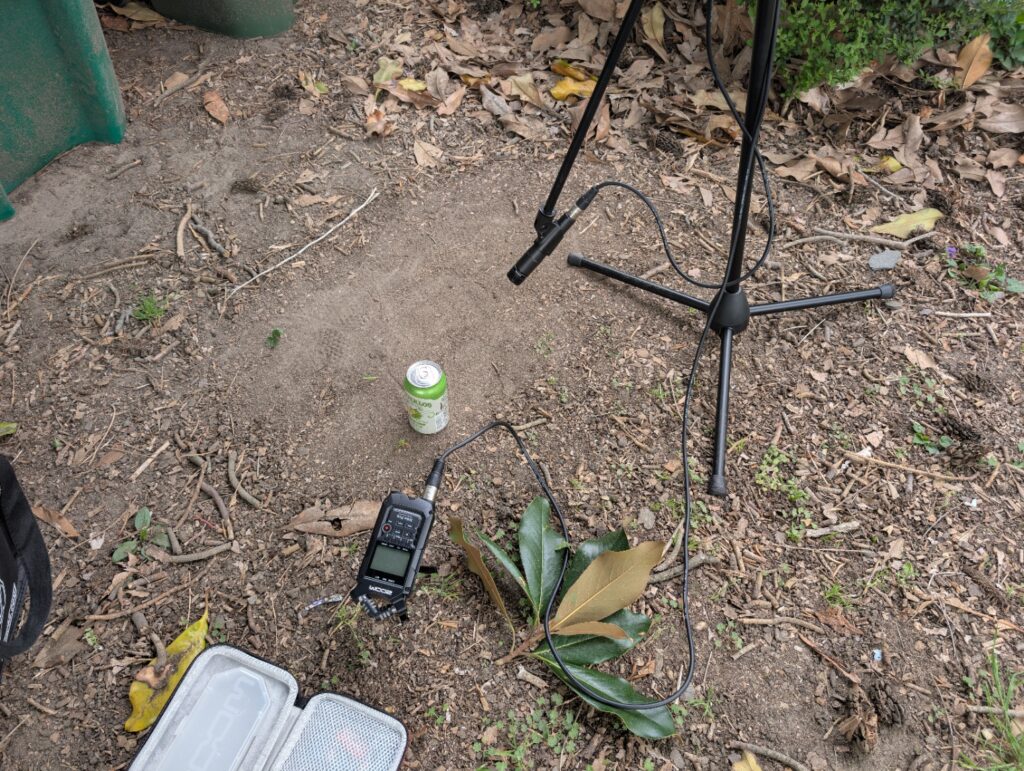
I also recorded some footsteps outside by putting my hand in an old pair of leather shoes and just pounding the dirt here. I did as much as I could recording outside during the day, but I ended up recording some sounds in the nighttime for reduced noise, due to the weekend being the same weekend as the 50501 protests in my city.
I did have a couple of sound effects that were designed sound effects. The first one I want to talk about is the sound when the plant grows to a different stage. That sound starts with a recording of myself rustling some dry leaves, then it’s later joined by a Rhodes-type synthesizer on top of another synthesizer that makes a bell sound. I EQ’d the sounds to bring out certain frequencies I wanted in each sound, then I added a bit of reverb and compression to taste. I wanted to give it a sort of “ethereal” sound quality to it.
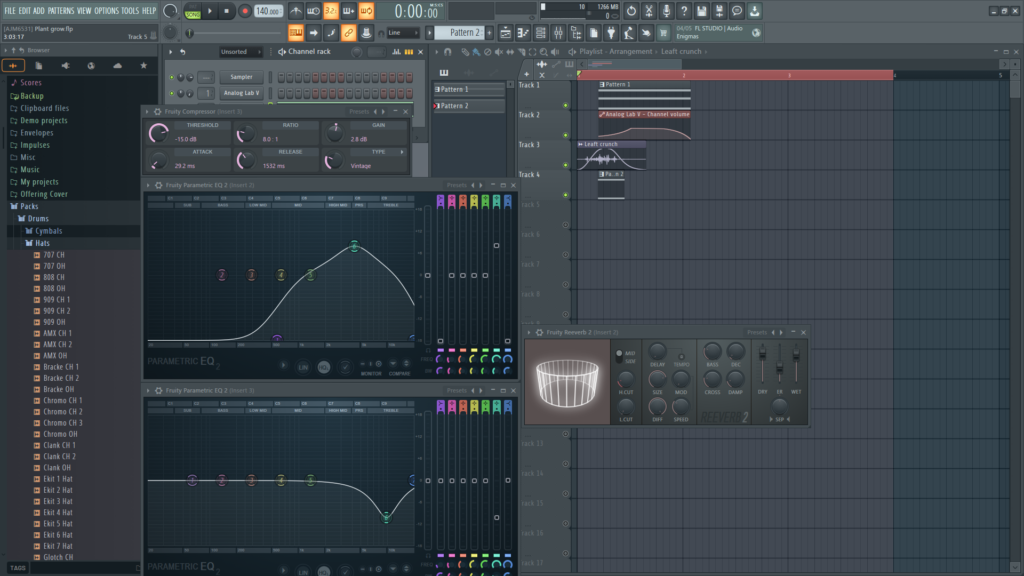
Speaking of ethereal sounds, let’s talk about the sound the dark liquid altar makes when a player gets near it. That sound was a result of a happy accident. I was working on getting the dark liquid pouring sound effect for the plant and the sounds I was making with my water recordings just weren’t hitting the mark. I was experimenting with that water-sloshing sound I recorded with a patcher preset in FL studio called “Gross Ambience”, and didn’t get anywhere until I noticed the sound the reverb made. The tail end of the reverb created a sort of ominous sound that had some voice-like quality to it.
I knew I had to use that sound, so what I did was I took a recording of just the tail end of that sound, found some good looping spots, and since the sound was in the midst of fading away, I evened out the beginning and end volume so that it would be at a constant volume. The end sound gives that altar a strange and creepy vibe.
To wrap up the sound effects section here, I want to talk about how I ended up making the dark liquid pour sound effect. I wanted to record some sounds of myself pouring some thick liquid like paint or something, but I did not have any substances like that around the house. In a pinch, I ended up using a sound I found on the freesound website. I made sure the sound was CC0 licensed though, and I also wanted to heavily modify the sound as well to give the sound an alien/ not of this world vibe. I was able to achieve the effect with another patcher preset in FL studio, this time it was the multiband dynamic distortion tool.
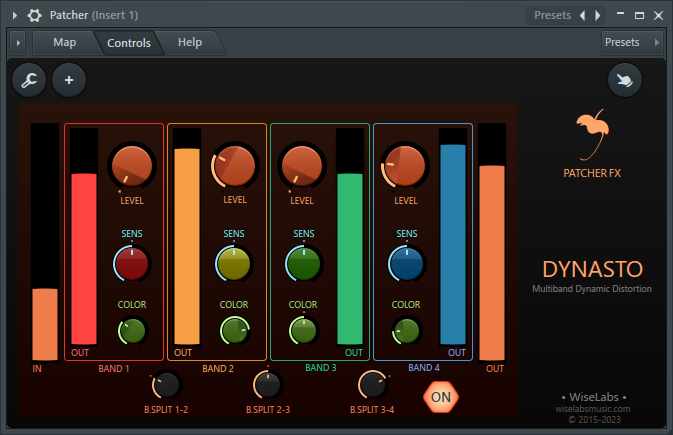
That pretty much sums up the sound effects for this game. As I’ve said, most of the sounds were just recording the real-life equivalent and cleaning it up. Let me know if I missed something by sending me a message, If anyone has any questions as well, I am always happy to reach back out and answer them! For now, let’s move on to the music!
Rock n Roll
The music is always one of the most fun, but also the most intimidating part of being on the sound team. Of course there is joy in creating something artistic, but at the same time, there is always this lingering self doubt and fear of failure in the back of my mind. In the end though, it all worked out and now I’m super excited to tell you all about my thought process behind the main theme.
From the beginning, I was requested to make a song that was roughly 3 minutes in length and a song that increased in intensity as the time ran out. Everything else I had total creative control over.
When I thought about the chaotic nature of the gameplay, the unserious nature of the subject, and the setting of Death Valley, I landed upon making a song in the style of rockabilly/1950s rock n roll Americana. This was the first time I had ever attempted to make something intentionally outside of the electronic music genre, which is where my comfort zone was.
The first thing I ended up doing was listening to a bunch of examples and reading up on the genre online. I admit I was intimidated by re-creating the style of the genre, especially when on the surface it sounds a little complex. The more I dug into it, however, I realized this music was pretty simple to make! Pretty much most of the songs in that genre utilizes a I-IV-V chord progression. In terms of music theory, this is pretty much as simple as you can get, trust me, certain genres of music get MUCH more complicated than this. Because the chords you use for this genre are set in stone, all that is needed is to “throw a dart” at what key signature you want to use. For my song, I ended up doing a slight variation of the chord progression (I-IV-V-IV) in the key of F major. Just a side note here, it seems like most of my music these days is either in D major or F major. I did try playing some chords in some key signatures I never touch to challenge myself, but I ended up gravitating toward F major.
While the chord progression may be set in stone, another hallmark of this style of music is the heavy utilization of the blues scale. I am a little shaky when it comes to memorizing nonmajor/minor scales if I’m being honest, but the blues scale is pretty much your typical major scale with some flats thrown into it. This also fits thematically with the vibe of the game, because most music that tends not to take itself seriously, such as the Banjo Kazooie soundtrack, has musical lines that venture off from an established scale and add a lot of chromatics (flats/sharps) to it. This applies to the bass line of this track. I wrote a bass that walks up and down the notes in the F major scale while adding some bluesy flats to certain notes as well.
The melody of the track pretty much went by ear and feel. I wanted to use a saxophone sound that sounded realistic. Because I don’t own a saxophone, nor know anyone who plays that instrument, I was reliant on software plugins for the saxophone sound. Admittedly, I did not want to spend a lot of money on this game jam project, so I looked up some free software plugins for the saxophone, and pretty much everyone I tried was not very good. After looking around for a good sax sound, I received a picture from the group chat showing the design of the main character. The demon character ended up being adorable. Because of this character design, I decided to lean into a “terrible” sax sound. I used a general MIDI sax sound. To also add to the un-seriousness of the game, I utilized heavy pitch bending when playing the sax part on my keyboard.
On the subject of playing on my keyboard, every instrument on the track was played using my MIDI keyboard, including the guitars. This was a real challenge because I don’t own a guitar, so it was both figuring out how to source the guitar sound and how to play it like a real guitarist. For the first point, I ended up using the FL flex synthesizer that had a preset bank for realistic guitars. I even used these banks for the bass guitar as well. I was surprised by how realistic they sounded, to the point they even emulated the sound of the fingers moving up and down the frets. I made sure the sound of the guitars had that echo and reverb that is a hallmark of the genre and played them to the best of my ability. I admit, I still think the guitars sound a little like a keyboardist played them, but it still ended up sounding good. I am especially proud of the second guitar that comes in on the song. With that particular guitar, I fed the sound through a guitar amp distortion patcher preset that added a nice color to the sound and made it stand out.
The only thing I can say about the drums is that It was something I programmed very quickly. It is a little robotic playing the same thing over and over, but the drums are really never flashy in any of the songs I listened to, so it’s fine for them to stay in the background and just be there, adding a little flavor to the track.
For the track, I intentionally made it so that as time goes on, there is a little bit of an increase in intensity with the instrumentation, adding more and more layers. Around 30 seconds before the song ended, I ended up repeating the first 4 bars of the beginning melody line with all the instruments, but slowly increasing the track tempo, and tuning every instrument up half a step (or 1 semitone) each time the first 4 bars get repeated. To quote Stewart Copeland, composer for Spyro the Dragon, “This is where Mozart would be jumping out of his grave saying ‘I want to live in this century’”
For the very last part of the track, I cut the first 4 bars to 1 bar, and added some slight variation to one of the guitars so that it isn’t hammering the same note. I was also requested to make a “womp, womp” noise at the very end, so I did a piano slide down the keyboard for the sax and did some sad pitch bending noises to top it off.
For the actual mixing and mastering of the track, If I went into full detail about it, this would be an even longer post. To briefly summarize, I tried to carve out space for each instrument by using EQs, panning, and compression. I ran everything on the master through a convolution reverb to make every instrument sound like it was performed in the same space. Mastering was done using the vintage rock preset through Ozone. Here’s a peek into that whole process, when my whole screen looked like a mess.
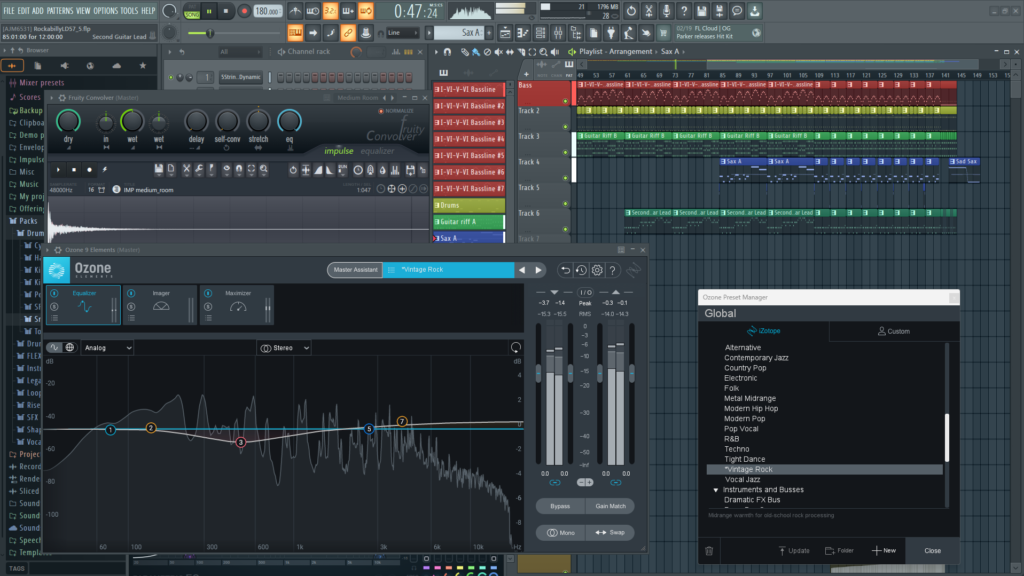
Conclusion
This project was a lot of fun to work on! It really gave me a lot of challenges I hadn’t faced before. I am, again, truly grateful to have the opportunity to work with Val and Ray on this project! If anyone has any further questions about anything or is curious about anything else I do, feel free to reach out to me through this website either by comment or by email. Feel free to reach out as well if you would like me to collab on your project!
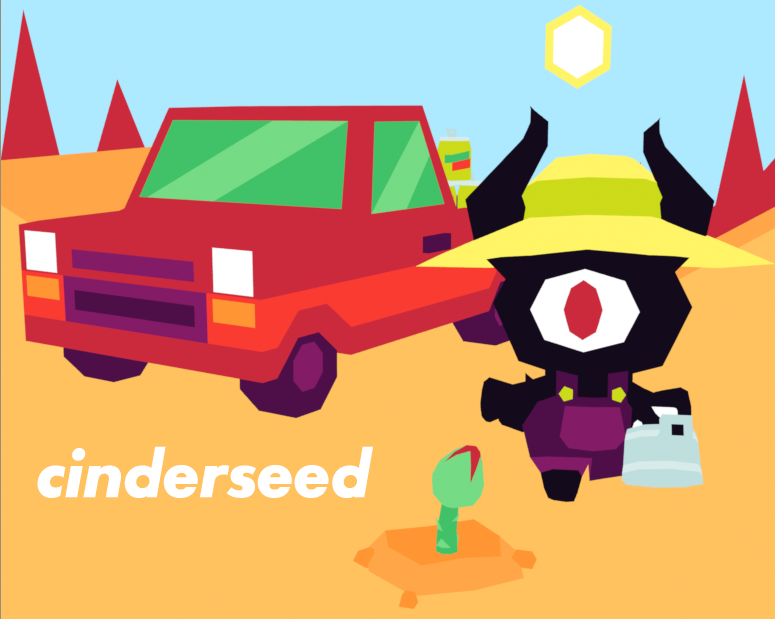
Leave a Reply